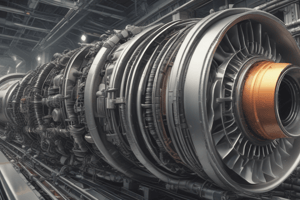Podcast
Questions and Answers
What are the two methods used for cooling the flame-tube?
What are the two methods used for cooling the flame-tube?
- Using a ring of large gaps
- Using a corrugated ‘wigglestip’ (correct)
- Using a ring of large holes
- Leaving wide annular gaps between overlapping sections
Why is predicting the flame-tube temperature from an energy balance not accurate?
Why is predicting the flame-tube temperature from an energy balance not accurate?
- Due to high air-fuel ratios
- Due to varying emissivities (correct)
- Due to narrow annular gaps
- Due to low turbine inlet temperatures
What is the effect of higher turbine inlet temperatures on the cooling potential of the air?
What is the effect of higher turbine inlet temperatures on the cooling potential of the air?
- It makes effusion cooling unnecessary
- It increases the cooling potential of the air
- It reduces the cooling potential of the air (correct)
- It has no effect on the cooling potential of the air
What is effusion cooling?
What is effusion cooling?
What is the current state of development for combustion chamber design?
What is the current state of development for combustion chamber design?
Flashcards are hidden until you start studying
Study Notes
- Cooling the flame-tube is a problem as permissible turbine inlet temperatures increase.
- The flame-tube receives energy by convection and radiation, but loses energy by convection and radiation as well.
- Leaving narrow annular gaps between overlapping sections of the flame-tube is a common practice for cooling it.
- Corrugated ‘wigglestip’ and a ring of small holes are two methods used for cooling the flame-tube.
- Prediction of the flame-tube temperature from an energy balance is not accurate due to varying emissivities.
- Final development of combustion chamber design is still a matter of trial and error on the test rig.
- The emissivity of the flame varies with the type of fuel.
- Higher turbine inlet temperatures imply the use of lower air-fuel ratios, which reduces the cooling potential of the air.
- If permissible turbine inlet temperatures increase much beyond 1500 K, effusion cooling may have to be used.
- Effusion cooling is more economical in cooling air than film cooling.
Studying That Suits You
Use AI to generate personalized quizzes and flashcards to suit your learning preferences.



